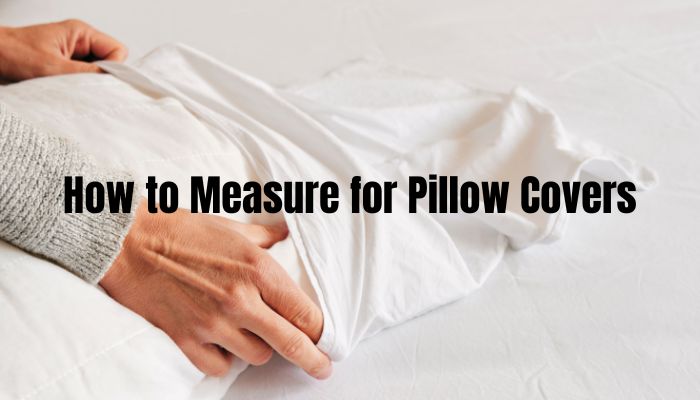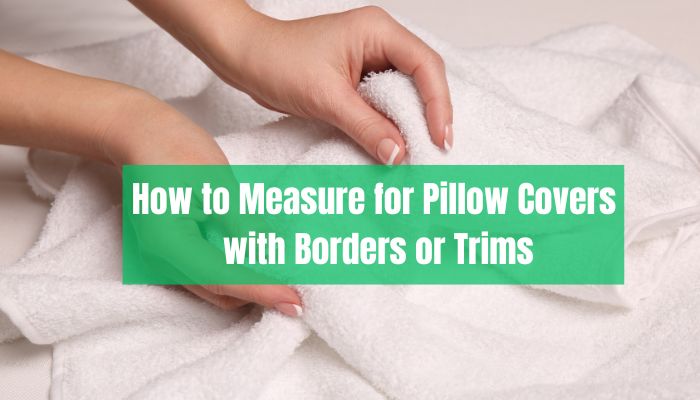Master the art of pillow measurement with our easy guide. Unearth the secrets of getting perfect dimensions every time for a flawless pillow cover fit!
Paying attention to the pillows is essential to adorn your bedroom with the perfect look and feel. The size and shape of pillows are pivotal, and understanding pillow cover measurement is a must to ensure a seamless fit and a consistent aesthetic appeal.
Why Accurate Measurements are Crucial
Accurate measurements are crucial in several ways. They guarantee the optimal fit for your pillows and ensure the pillow cover’s durability. An ill-fitted pillow cover can lead to excessive stretching or slackness, which can degrade the material over time. A perfect fit also enhances the overall look of your bed and the room, making the space appear more put-together.
Different Types of Pillows
Pillows are rectangular and serve a multipurpose role, offering comfort for sleeping and decorative purposes.
Orthopedic pillows are made with a specified shape to give the body the best support possible. Especially for the neck and back- they are frequently utilized to relieve discomfort or pain.
Travel Pillows are compact, often U-shaped pillows designed to provide neck support while traveling.
Decorative Pillows, or throw pillows, are used primarily for aesthetic purposes, available in various sizes, shapes, and designs.
Standard Pillow Sizes
In the realm of standard pillows, there are generally accepted sizes.
Standard Size: The most common pillow size is 20 inches by 26 inches, which fits most twin and full-sized beds.
Queen Size: Queen pillows are slightly longer, measuring 20 inches by 30 inches. They are perfect for queen-sized beds.
King Size: The largest of standard pillows, the king size measures 20 inches by 36 inches, fitting king-sized beds.
Varieties of Pillow Shapes
Pillow shapes can vary greatly, adding different aesthetics to your bedroom. The most common shapes are:
Square: Typically used for decorative purposes, these pillows are usually 16 to 20 inches per side.
Rectangle (Lumbar): These pillows provide lower back support and are often used for decoration. Their size varies greatly, but they typically measure 12 inches in height.
Round: Round or bolster pillows are typically used for decorative purposes or for supporting the neck. They vary in diameter and length.
Box: These pillows have a chunky, square shape and are generally used for decoration. They usually measure between 16 to 20 inches per side.
As you navigate the universe of pillows, armed with the knowledge of measurements and variety, you will find the perfect pieces to create a cozy and aesthetic space that speaks to your taste and meets your needs.

Essential Tools for Pillow Measurement
For precise pillow measurement, there are a few tools that prove invaluable. The key is to capture the dimensions accurately, as this can make the difference between a perfectly fitted pillow cover and one that falls short of expectations.
Why You Need a Measuring Tape
The ideal item to use while measuring pillows is a flexible measuring tape. Unlike a straight ruler, a flexible measuring tape may readily bend around a pillow’s body, giving a more precise measurement. Its flexible nature allows it to accurately trace the pillow’s contours, leading to a precise reading of dimensions that accounts for its fullness.
How to Measure for a Rectangular or Square Pillow Cover
Before cutting a pillow cover, a rectangle or square pillow’s length, width and thickness must be precisely measured.
Step-by-Step Instructions for Measuring Length, Width, and Thickness
Here is a guide with detailed instructions to help you precisely measure your square or rectangle pillow:
Step 1: Start with determining the pillow’s length. Place the measuring tape’s end at one pillow corner and extend it to the other. Ensure the tape lies flat against the pillow’s surface for an accurate measurement.
Step 2: Next, gauge your pillow’s width. Once more, make sure the measuring tape lies flat; start at one side of the cushion and extend it to the other.
The third and last step is to gauge the thickness of your pillow. You can measure from top to bottom by lightly pressing down on the pillow’s top.
To obtain a tight fit for your pillow cover, it is imperative to note that measurements should be taken at the areas of the pillow that are the bulkiest. All these measurements are integral to picking or designing the perfect cover that protects your pillow and adds to the aesthetic appeal of your living space.
Read more about How to Stop Pillows from Falling Behind Bed | Bedroom Solutions
Measuring for Round or Bolster Pillow Covers
A different approach is required to measure accurately for round or bolster pillows. You’ll primarily need to measure the diameter and length.
How to Accurately Measure Diameter and Length
Lay your pillow out flat to begin measuring the diameter of a round pillow. The middle of the pillow should be measured directly from one side to the other using a measuring tape. This measurement is the diameter.
To measure the length of a bolster pillow, place one end of the measuring tape at one end of the pillow and extend it straight to the other end. This is your length measurement. For both measurements, be sure the tape lies flat and snug against the pillow for an accurate reading.
Guidelines for Measuring Unusual and Irregularly Shaped Pillows
Unusual and irregularly shaped pillows pose a challenge regarding measurement. The key is to measure the widest and longest points and consider any unique contours or angles the pillow cover needs to accommodate. When in doubt, it’s better to err on the side of a slightly larger measurement to ensure the pillow cover will fit.
Common Pitfalls in Measuring for Pillow Covers
While measuring for pillow covers may seem straightforward, there are common pitfalls that can result in inaccurate measurements.
Ensuring Precise Measurements: Do’s and Don’ts
- Do: Use a flexible measuring tape. This will allow for accurate measurements that account for the pillow’s fullness.
- Don’t: Pull the measuring tape too tight. This could lead to too small measurements and a pillow cover that needs to fit correctly.
- Do: Measure all the necessary dimensions: length, width, and thickness (for rectangular and square pillows) or diameter and length (for round or bolster pillows).
- Don’t: Ignore the thickness of the pillow. Many people make the mistake of only measuring the length and width, but the thickness can also impact the fit of the cover.
By being mindful of these do’s and don’ts, you can ensure precise measurements that lead to a perfect fit for your pillow covers.
How to Measure for Pillow Covers with Borders or Trims

Pillow covers with borders or trims can elevate the aesthetic appeal of your pillow, but they require careful measurement. In addition to the measurements of the pillow itself, you should measure the width of the border or trim. This is done by measuring from the seam where the border or trim starts to its outer edge.
Interpreting Your Measurements for the Right Pillow Cover Size
Once you have your pillow measurements, it’s essential to interpret them correctly for the right pillow cover size. Pillow cover size usually corresponds to the pillow’s dimensions. However, choose a pillow cover 1 to 2 inches smaller than your pillow dimensions for the best fit. This helps the cover to fit snugly over the pillow without leaving any loose or excess fabric.
Decoding Pillow Cover Size Labels
Size labels typically list a pillow cover’s width and length in inches and split the measurements with an “x.” Using the label “18 x 18” as an example, we can see that it refers to the cushion cover’s width and length- 18 inches. If a third number appears, it typically denotes the cover’s depth or thickness.
Read more about How to Clean Up Feathers From Pillow Fight?
Frequently Asked Questions About Measuring for Pillow Covers
Q: What if my pillow is a different size?
A: Consider purchasing or making a custom pillow cover for non-standard-sized pillows that fits your specific measurements.
Q: Should I measure my pillow or my existing pillow cover?
A: Always measure your pillow. The existing cover might need to fit correctly, giving you inaccurate measurements.
